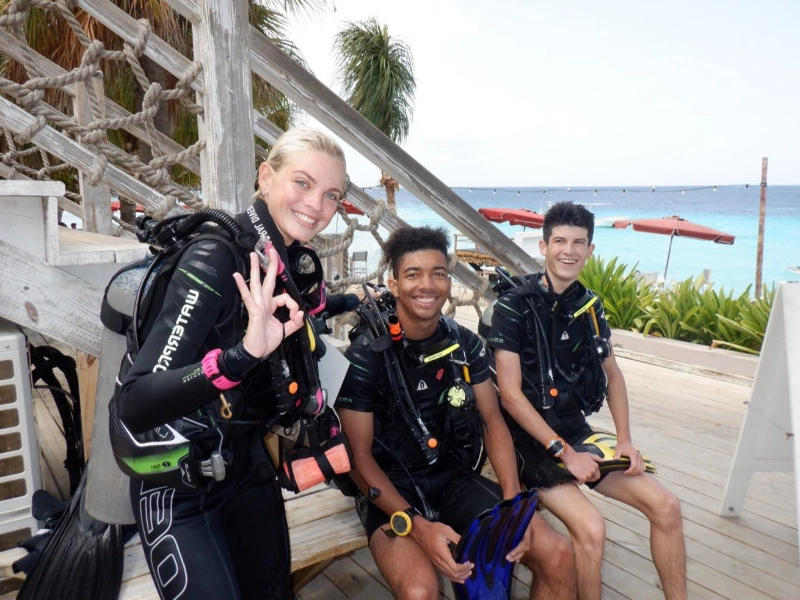Scuba Diving Algorithms: Comprehending Your Safety Margin
Your No Decompression Limit (NDL) is computed by dive computers using algorithms. Your body's various components absorb and release gas at different rates. For this reason, different algorithm models are provided by dive computer manufacturers. Choosing the model that most closely matches yourphysiology and risk tolerance is crucial.
Computer algorithms for diving

The Buhlmann algorithm
 Algorithms are the unseen defenders that make sure every diving excursion is exciting and secure. It's crucial to comprehend how they operate in order to select the best dive computer for you.
Different theoretical underpinnings are behind the decompression computations of each algorithm model. The Buhlmann algorithm is among the models that is most frequently utilised. It operates on the principle that distinct tissue compartments have varying rates of inert gas absorption and elimination. The programme calculates safe ascent rates and decompression pauses based on these rates.
Individual physiology is taken into consideration by several modern algorithms, which include age, risk tolerance, and fitness level. These variables may affect the algorithm's liberal or conservative settings and how your decompression profiles are created. This can have a big impact on your dive's safety margins and how near you are to the no-decompression limit.
Algorithms are the unseen defenders that make sure every diving excursion is exciting and secure. It's crucial to comprehend how they operate in order to select the best dive computer for you.
Different theoretical underpinnings are behind the decompression computations of each algorithm model. The Buhlmann algorithm is among the models that is most frequently utilised. It operates on the principle that distinct tissue compartments have varying rates of inert gas absorption and elimination. The programme calculates safe ascent rates and decompression pauses based on these rates.
Individual physiology is taken into consideration by several modern algorithms, which include age, risk tolerance, and fitness level. These variables may affect the algorithm's liberal or conservative settings and how your decompression profiles are created. This can have a big impact on your dive's safety margins and how near you are to the no-decompression limit.
VPM Process
 The decompression algorithm in your dive computer and desktop table generation software is probably not a big deal for most recreational divers. All of the current algorithms will safely remove recreational divers from the water provided that the default conservancy settings are set appropriately and their dive profiles are designed to reflect real breathing gas compositions.
To increase their safety margins, divers are advised to enrol in advanced dive courses that go further into decompression theory and dive planning. It's a good idea to familiarise yourself with the suggested settings and any safety aspects that can be adjusted on your dive computer. This will assist you in organising dives that safely intercept established no-decompression boundaries while leaving plenty of room for error. For repeated dives, for instance, ZHL-16C GF-Hi=GF-Lo=70 and EMC-20H (conservatism factor of 0) can be adjusted to prescribe suitably brief NSTs.
The decompression algorithm in your dive computer and desktop table generation software is probably not a big deal for most recreational divers. All of the current algorithms will safely remove recreational divers from the water provided that the default conservancy settings are set appropriately and their dive profiles are designed to reflect real breathing gas compositions.
To increase their safety margins, divers are advised to enrol in advanced dive courses that go further into decompression theory and dive planning. It's a good idea to familiarise yourself with the suggested settings and any safety aspects that can be adjusted on your dive computer. This will assist you in organising dives that safely intercept established no-decompression boundaries while leaving plenty of room for error. For repeated dives, for instance, ZHL-16C GF-Hi=GF-Lo=70 and EMC-20H (conservatism factor of 0) can be adjusted to prescribe suitably brief NSTs.
RGBM Method
 One of the most popular algorithms in dive computers for recreational use is RGBM. The reason for this is that it offers a conservative first significant stop test, which reassures novice divers that their computer can safely ascend them without running the risk of experiencing decompression sickness.
It's critical to keep in mind that no algorithm model will ever be 100% accurate. There will always be a role for your personal physiology and varied DCS predisposing factors in your diving safety.
You should adjust the conservatism settings on your dive computer according to your age, degree of exercise, and risk tolerance in order to get the most out of your diving. In this manner, you can select an algorithm that best suits your requirements and yields the finest potential dive profiles. In the end, there is no other way to guarantee that the computations made by your computer are as precise as possible.
One of the most popular algorithms in dive computers for recreational use is RGBM. The reason for this is that it offers a conservative first significant stop test, which reassures novice divers that their computer can safely ascend them without running the risk of experiencing decompression sickness.
It's critical to keep in mind that no algorithm model will ever be 100% accurate. There will always be a role for your personal physiology and varied DCS predisposing factors in your diving safety.
You should adjust the conservatism settings on your dive computer according to your age, degree of exercise, and risk tolerance in order to get the most out of your diving. In this manner, you can select an algorithm that best suits your requirements and yields the finest potential dive profiles. In the end, there is no other way to guarantee that the computations made by your computer are as precise as possible.
Technical Algorithm Suunto
 The AEON Steel and AEON Core dive computers use the Suunto RGBM algorithm, a flexible and resilient approach that controls both free and dissolved nitrogen. It is intended to prevent dangerous nitrogen bubble development while bringing you as close as possible to your no-decompression limit.
Compared to other dive computer manufacturers, Suunto takes a novel approach to decompression modelling using traditional Haldane-based techniques. It has several customisable parameters for conservative and lets you modify the gradient factors and safety stop durations. This customisation can help reduce the risk of DCS by taking into account your unique physiology and varied predisposing factors. Additionally, it enables you to dive using a combination of shallow and deep profiles.
The AEON Steel and AEON Core dive computers use the Suunto RGBM algorithm, a flexible and resilient approach that controls both free and dissolved nitrogen. It is intended to prevent dangerous nitrogen bubble development while bringing you as close as possible to your no-decompression limit.
Compared to other dive computer manufacturers, Suunto takes a novel approach to decompression modelling using traditional Haldane-based techniques. It has several customisable parameters for conservative and lets you modify the gradient factors and safety stop durations. This customisation can help reduce the risk of DCS by taking into account your unique physiology and varied predisposing factors. Additionally, it enables you to dive using a combination of shallow and deep profiles.








